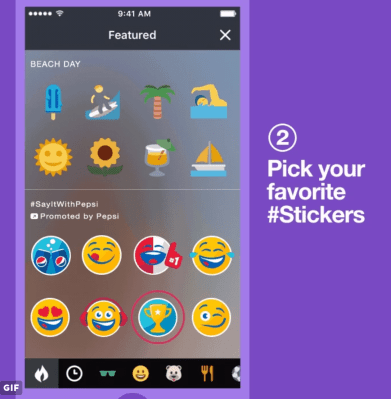Twitter made its stickers for photos available to everyone at the end of last month, and now the company has quickly followed that up with the launch of its first branded stickers.
Twitter calls them “promoted stickers” but essentially they are branded stickers… well subtly branded stickers, at least.
Pepsi is the first partner on board in an undisclosed deal that allows Twitter users to plaster stickers designed by the fizzy pop company onto their photos. Doing so and posting the photo triggers a hashtag to appear inside the tweet, which makes it discoverable to Pepsi — perhaps for further promotion or competitions — and that, in turn, helps promote the brand in a different way on Twitter. That’s the theory, anyway.
Twitter explained more in a blog post, and with the tweet below:
Brands can design four or eight stickers — like accessories and other props — for users to add to their own photos. Photos with a brand’s stickers are shared with all of a user’s followers, allowing brands to be featured by their fans in a truly authentic way. #Stickers act as a visual hashtag, meaning that photos with your brand’s sticker will be connected and discoverable to anyone who taps your brand’s sticker. This allows a brand to see and engage with the people who are using their stickers in creative ways.
This is an interesting move from Twitter designed to help brands do more than just advertise via Promoted Tweets and video units on its service. Last year, the company began letting companies pay for branded emojis — ironically it was Coke, not Pepsi, which was the launch partner for that particular initiative — so expanding into more visual media, such as photos, was to be expected at some point.
Twitter can take its cues from Snapchat, which has helped feed America’s appetite for stickers and is itself monetizing photos using geo-filters, and Facebook, which has allowed stickers on photos since last year albeit without brand involvement, while further afar Asia-based messaging companies like Line have pioneered stickers are items paid for by both users and brands, too.
Line, which held a successful IPO this summer, made $270 million from selling stickers last year. While most of that came from users paying a few dollars for a sticker pay, one-third of Line’s $1 billion in revenue came from advertising from official accounts, which use stickers to raise awareness and gain subscribers.
Twitter is doing things a little differently of course, with its 140-character service. Can brands paying for more subtle visibility help it reach profitability, something the company has yet to achieve?
